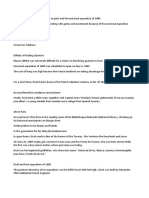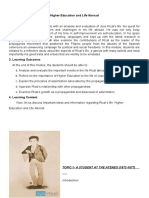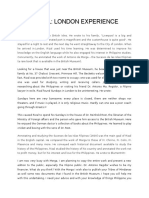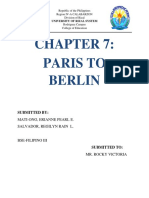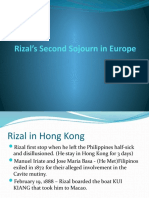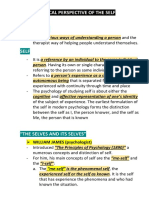100%(1)100% found this document useful (1 vote)
2K viewsChapter 8 Noli Me Tangere 1887
Chapter 8 Noli Me Tangere 1887
Uploaded by
Abdulaziz Hajimin DapilinThe document provides details about Jose Rizal's novel Noli Me Tangere, including:
1) Rizal began writing the novel in 1884 and finished it in 1887 while living in Madrid, Paris, and Berlin.
2) The novel was published in Berlin in March 1887 and depicted the oppression of the Filipino people under Spanish rule.
3) The title is a Latin phrase meaning "Touch Me Not" taken from the Bible, and Rizal dedicated the novel to the Philippines.
Copyright:
© All Rights Reserved
Available Formats
Download as PDF, TXT or read online from Scribd
Chapter 8 Noli Me Tangere 1887
Chapter 8 Noli Me Tangere 1887
Uploaded by
Abdulaziz Hajimin Dapilin100%(1)100% found this document useful (1 vote)
2K views11 pagesThe document provides details about Jose Rizal's novel Noli Me Tangere, including:
1) Rizal began writing the novel in 1884 and finished it in 1887 while living in Madrid, Paris, and Berlin.
2) The novel was published in Berlin in March 1887 and depicted the oppression of the Filipino people under Spanish rule.
3) The title is a Latin phrase meaning "Touch Me Not" taken from the Bible, and Rizal dedicated the novel to the Philippines.
Original Description:
Jose Rizal publish Noli Me Tangere
Copyright
© © All Rights Reserved
Available Formats
PDF, TXT or read online from Scribd
Share this document
Did you find this document useful?
Is this content inappropriate?
The document provides details about Jose Rizal's novel Noli Me Tangere, including:
1) Rizal began writing the novel in 1884 and finished it in 1887 while living in Madrid, Paris, and Berlin.
2) The novel was published in Berlin in March 1887 and depicted the oppression of the Filipino people under Spanish rule.
3) The title is a Latin phrase meaning "Touch Me Not" taken from the Bible, and Rizal dedicated the novel to the Philippines.
Copyright:
© All Rights Reserved
Available Formats
Download as PDF, TXT or read online from Scribd
Download as pdf or txt
100%(1)100% found this document useful (1 vote)
2K views11 pagesChapter 8 Noli Me Tangere 1887
Chapter 8 Noli Me Tangere 1887
Uploaded by
Abdulaziz Hajimin DapilinThe document provides details about Jose Rizal's novel Noli Me Tangere, including:
1) Rizal began writing the novel in 1884 and finished it in 1887 while living in Madrid, Paris, and Berlin.
2) The novel was published in Berlin in March 1887 and depicted the oppression of the Filipino people under Spanish rule.
3) The title is a Latin phrase meaning "Touch Me Not" taken from the Bible, and Rizal dedicated the novel to the Philippines.
Copyright:
© All Rights Reserved
Available Formats
Download as PDF, TXT or read online from Scribd
Download as pdf or txt
You are on page 1of 11
At a glance
Powered by AI
Rizal wrote Noli Me Tangere to depict the suffering of the Filipino people under Spanish rule. It took him several years to write while living in different countries in Europe. The novel was finally published in 1887 in Berlin.
Harriet Beecher Stowe's novel Uncle Tom's Cabin inspired Rizal to write a novel depicting the miseries of the Filipino people under Spanish tyranny.
Rizal began writing Noli Me Tangere in 1884 in Madrid and continued writing it in Paris and Germany between 1884-1886. He finished the final revisions in Berlin in 1886.
CHAPTER 8:
NOLI ME TANGERE
(1887)
The bleak winter of 1886 in Berlin was Rizals
darkest winter because no money arrived from
Calamba and he was flat broke. The diamond
ring which his sister, Saturnina, gave him was
in the pawnshop. It was memorable in the life
of Rizal for two reasons (1) it was a painful
episode for he was hungry, sick and
despondent in a strange city (2) it brought him
great joy after enduring so much sufferings,
because his first novel, Noli Me Tangere came
off the press in March, 1887
Harriet Beecher Stowes Uncle Toms Cabin-
inspired Dr. Rizal to prepare a novel that would
depict the miseries of his people under the lash
of Spanish tyrants
January 2, 1884- in a reunion of Filipinos in the
Paterno residence in Madrid, Rizal proposed
the writings of a novel about the Philippines by
a group of Filipinos
Toward the end of 1884, Rizal began writing
the novel in Madrid and finished about one-half
of it
When Rizal went to Paris, in 1885, after
completing his studies in the Central University
of Madrid, he continued writing the novel,
finishing one half of the second half
Rizal finished the last fourth of the novel in
Germany. He wrote the last few chapters of the
Noli in Wilhelmsfeld in April-June, 1886
In Berlin during the winter days of February,
1886, Rizal made the final revisions on the
manuscript of the Noli
Maximo Viola- Rizals friend from Bulacan,
arrived in Berlin at the height of Rizal
despondency and loaned him the needed
funds to publish the novel; savior of Noli
After the Christmas season , Rizal put the
finishing touches on his novel. To save printing
expenses, he deleted certain passages in his
manuscript, including a whole chapterElias
and Salome
February 21, 1887- the Noli was finally finished
and ready for printing
Berliner Buchdruckrei-Action-Gesselschaft- a
printing shop which charged the lowest rate,
that is, 300 pesos for 2,000 copies of the novel
March 21, 1887- the Noli Me Tangere came off
the press
March 29, 1887- Rizal, in token of his
appreciation and gratitude, gave Viola the
galley proofs of the Noli carefully rolled around
the pen that he used in writing it and a
complimentary copy, with the following
inscription: To my dear friend, Maximo Viola,
the first to read and appreciate my workJose
Rizal
The title Noli Me Tangere is a Latin phrase
which means Touch Me Not. It is not
originally conceived by Rizal, for he admitted
taking it from the Bible
Rizal, writing to Felix Hidalgo in French on
March 5, 1887, said: Noli Me Tangere, words
taken from the Gospel of St. Luke, signify do
not touch me but Rizal made a mistake, it
should be the Gospel of St. John (Chapter 20
Verses 13 to 17)
Rizal dedicated his Noli Me Tangere to the
PhilippinesTo My Fatherland
The cover of Noli Me Tangere was designed
by Rizal. It is a ketch of explicit symbols. A
womans head atop a Maria Clara bodice
represents the nation and the women, victims
of the social cancer. One of the causes of the
cancer is symbolized in the friars feet,
outsized in relation to the womans head. The
other aggravating causes of oppression and
discrimination are shown in the guards helmet
and the iron chains, the teachers whip and the
alferezs scourge. A slight cluster of bamboo
stands at the backdrop; these are the people,
forever in the background of their own
countrys history. There are a cross, a maze,
flowers and thorny plants, a flame; these are
indicative of the religious policy, the
misdirected ardor, the people strangled as a
result of these all
The novel Noli Me Tangere contains 63
chapters and an epilogue
Dr. Antonio Ma. Regidor- Filipino patriot and
lawyer who had been exiled due to his
complicity in the Cavite Mutiny of 1872, read
avidly the Noli and was very much impressed
by its author
CHARACTERS OF NOLI
The Noli Me Tangere was a true story of the
Philippine conditions during the last decades
of Spanish rule
o Maria Clara-was Leonor Rivera, although in
real life she became unfaithful and married
an Englishman
o Ibarra and Elias- represented Rizal himself
o Tasio-the philosopher was Rizals elder
brother Paciano
o Padre Salvi-was identified by Rizalists as
Padre Antonio Piernavieja, the hated
Augustinian friar in Cavite who was killed by
the patriots during the Revolution
o Capitan Tiago-was Captain Hilario Sunico
of San Nicolas
o Doa Victorina- was Doa Agustina Medel
o Basilio and Crispin- were the Crisostomo
brothers of Hagonoy
o Padre Damaso- typical of a domineering
friar during the days of Rizal, who was
arrogant, immoral and anti-Filipino.
You might also like
- Rizal's First Travel Abroad: (SPAIN 1882 - 1885)Document16 pagesRizal's First Travel Abroad: (SPAIN 1882 - 1885)SheilaGoEspinosaNo ratings yet
- Chapter 15 - 16Document6 pagesChapter 15 - 16Danica Franco100% (4)
- Chapter 22 25Document7 pagesChapter 22 25judy ann naluz100% (1)
- Guillain-Barré Syndrome: I. Anatomical and Physiological BackgroundDocument8 pagesGuillain-Barré Syndrome: I. Anatomical and Physiological BackgroundSteve ColbertNo ratings yet
- Unit 14-Select and Using Secondary Machining BTEC Level 2Document30 pagesUnit 14-Select and Using Secondary Machining BTEC Level 2Samantha AshmanNo ratings yet
- Noli Me Tangere Published in BerlinDocument1 pageNoli Me Tangere Published in BerlinJusil T. GaiteNo ratings yet
- Rizal Chapter 7&8Document34 pagesRizal Chapter 7&8Oliver Salvador BersaminaNo ratings yet
- Module 4.rizal Higher EducationDocument20 pagesModule 4.rizal Higher EducationRalph Vincent Valdez TamangNo ratings yet
- Chapter 8 RizalDocument15 pagesChapter 8 RizalKarl BognotNo ratings yet
- Reflection 1Document3 pagesReflection 1Azed DragneelNo ratings yet
- Chapter 12Document20 pagesChapter 12Trixie Rose Ebona CortezNo ratings yet
- Rizal in London: Geronimo, Lea Mae B., Rieza, Irish Kay T., Roxas, Marianne Francine., & Verzo, Andrea RDocument38 pagesRizal in London: Geronimo, Lea Mae B., Rieza, Irish Kay T., Roxas, Marianne Francine., & Verzo, Andrea RIrish Kay RiezaNo ratings yet
- Rizal Chapter 8Document6 pagesRizal Chapter 8JolieCNo ratings yet
- Life and Works of Rizal Chapter 4: Rizal'S Family, Childhood, and Early EducationDocument10 pagesLife and Works of Rizal Chapter 4: Rizal'S Family, Childhood, and Early EducationMarie Vivialyn Serrano100% (1)
- Chapter 3 SummaryDocument8 pagesChapter 3 SummaryCarl Joshua Malig CayananNo ratings yet
- Lesson 10 in The Eyes of Noli Me TangereDocument13 pagesLesson 10 in The Eyes of Noli Me TangereCare Baubi100% (1)
- Chapter 8: Noli Me Tangere Published in Berlin (1887)Document23 pagesChapter 8: Noli Me Tangere Published in Berlin (1887)Roger Yatan Ibañez Jr.No ratings yet
- Jose Rizal Chapter 2Document21 pagesJose Rizal Chapter 2Riecel Canson Makinano95% (37)
- LESSON 4 - Noli Me TangerteDocument5 pagesLESSON 4 - Noli Me TangerteAiron BendañaNo ratings yet
- Chapter 4 Topic1 RizalDocument5 pagesChapter 4 Topic1 RizalShine BravoNo ratings yet
- Family Tree of RizalDocument4 pagesFamily Tree of RizalEdward Almazan100% (1)
- The Avid Collector of RizalDocument1 pageThe Avid Collector of RizalSophia Catalan0% (1)
- SPAIN, Paris, Germany, Noli LatestDocument58 pagesSPAIN, Paris, Germany, Noli LatestAriel Dela CruzNo ratings yet
- Rizal in SpainDocument23 pagesRizal in SpainEric Cabalsa SaraginaNo ratings yet
- Chapter 8 Noli Me Tangere Published in Berlin1887Document37 pagesChapter 8 Noli Me Tangere Published in Berlin1887Diane Katrice Adalid67% (3)
- In Sunny SpainDocument3 pagesIn Sunny SpainAnonymous ht2L8xP100% (1)
- RIZAL CHAPTER 4-5 by ZaideDocument2 pagesRIZAL CHAPTER 4-5 by ZaideJanna DublasNo ratings yet
- Paris To Berlin (1885-1887)Document19 pagesParis To Berlin (1885-1887)Shaira Alliah de Castro100% (1)
- Why Rizal Went To SpainDocument4 pagesWhy Rizal Went To SpainKid ClydeNo ratings yet
- Jose Rizal Life EventsDocument3 pagesJose Rizal Life EventsJonah Anne Aldea100% (1)
- School Life at Ateneo and The University of Santo TomasDocument12 pagesSchool Life at Ateneo and The University of Santo TomasCedrick MatibagNo ratings yet
- Early Education in Calamba and BiñanDocument4 pagesEarly Education in Calamba and BiñanJoel Cinco100% (1)
- Jose Rizal in LondonDocument4 pagesJose Rizal in LondonShawn Michael Doluntap60% (5)
- Rizal Life and Works - CHapter 18Document9 pagesRizal Life and Works - CHapter 18Rizza M. MendozaNo ratings yet
- Rizal Suspected As Frenchy SpyDocument6 pagesRizal Suspected As Frenchy SpyMichael Labial Apostol50% (2)
- Rizal in Gay Paris, 1889-90Document30 pagesRizal in Gay Paris, 1889-90Rachelle Mae SalvadorNo ratings yet
- RIZAL CHAPTER 8 and 9Document6 pagesRIZAL CHAPTER 8 and 9Ken Eugene CabanelaNo ratings yet
- Rizal'S The Last Trip AbroadDocument21 pagesRizal'S The Last Trip AbroadLadybhem SialongoNo ratings yet
- Second Sojourn in EuropeDocument48 pagesSecond Sojourn in EuropeQuennie Ann Aguinaldo33% (3)
- Chapter 11 (Jose Rizal and Philippine Nationalism0Document35 pagesChapter 11 (Jose Rizal and Philippine Nationalism0Clarisse VasquezNo ratings yet
- Rizal's LifeDocument28 pagesRizal's LifePaul Pabilico Porras100% (1)
- Paris To BerlinDocument11 pagesParis To Berlinhazelakiko torres100% (1)
- Rizal Summaries Chapter 1 13Document30 pagesRizal Summaries Chapter 1 13yeahNo ratings yet
- Rizal's Second Sojourn in EuropeDocument17 pagesRizal's Second Sojourn in EuropeLi ReNo ratings yet
- Jose Rizal SCRIPTDocument11 pagesJose Rizal SCRIPTLouigie GutierrezNo ratings yet
- Jose P. Rizal. GsoberanoDocument7 pagesJose P. Rizal. GsoberanoElla SoberanoNo ratings yet
- Chapter 9: Rizal'S Grand Tour of Europe With Viola (1887)Document3 pagesChapter 9: Rizal'S Grand Tour of Europe With Viola (1887)Lyka Rose CantaNo ratings yet
- Rizal's Exile, Trial, Etc.Document23 pagesRizal's Exile, Trial, Etc.Mark Darius A. MabborangNo ratings yet
- RizalDocument22 pagesRizalJosal Mariano Jacinto100% (1)
- Chapter 6 in Sunny Spain VoyageDocument3 pagesChapter 6 in Sunny Spain VoyageMyke HaelNo ratings yet
- Rizal As SymbolDocument18 pagesRizal As SymbolLeila Janezza ParanaqueNo ratings yet
- RIZALDocument2 pagesRIZALmary grace cornelioNo ratings yet
- In Sunny Spain PDFDocument8 pagesIn Sunny Spain PDFAiron BendañaNo ratings yet
- History of El FilibusterismoDocument1 pageHistory of El FilibusterismoDaniel Lalas PadayhagNo ratings yet
- Rizal Last HoursDocument2 pagesRizal Last HoursAlyssa Katrin CruzNo ratings yet
- Chapter 12 Romantic Interlude in Japan (1888)Document17 pagesChapter 12 Romantic Interlude in Japan (1888)Aeliey Ace100% (2)
- A Brief Synopsis LRDocument3 pagesA Brief Synopsis LRJEFFREY VILLANGCANo ratings yet
- Rizal Died A CatholicDocument7 pagesRizal Died A Catholicveronica lunaNo ratings yet
- Tracing Jose Rizal'S RootsDocument18 pagesTracing Jose Rizal'S RootsAngela ReverezaNo ratings yet
- Rizal Life and Works - Chapter 4Document13 pagesRizal Life and Works - Chapter 4Rizza M. Mendoza100% (3)
- NOLI ME TANGERE-WPS OfficeDocument3 pagesNOLI ME TANGERE-WPS OfficeMichael A ZamoraNo ratings yet
- Personal and Social Capabilities (Pearson)Document1 pagePersonal and Social Capabilities (Pearson)mandriloquaiNo ratings yet
- Pergamon: Scope andDocument13 pagesPergamon: Scope andSaravananNo ratings yet
- 7.cimt & MRPDocument41 pages7.cimt & MRPOsama Malik0% (1)
- Massiah v. United States, 377 U.S. 201 (1964)Document10 pagesMassiah v. United States, 377 U.S. 201 (1964)Scribd Government DocsNo ratings yet
- Fine Lawless Bibian Goodall Eng302 TeamreportDocument45 pagesFine Lawless Bibian Goodall Eng302 Teamreportapi-131293010No ratings yet
- Read The Tale and Answer The Questions: © 2013. - All Rights ReservedDocument2 pagesRead The Tale and Answer The Questions: © 2013. - All Rights ReservedVikneshVeginNo ratings yet
- How To Cook Thehow To Cook The Perfect Perfect... Recipes by Felicity CloakeDocument26 pagesHow To Cook Thehow To Cook The Perfect Perfect... Recipes by Felicity CloakeAndra IacobNo ratings yet
- Sap Siemens Material Fico PDFDocument1 pageSap Siemens Material Fico PDFkumarrajdeepbsr50% (2)
- Study Guide InteractiefDocument65 pagesStudy Guide Interactiefnqh2009No ratings yet
- Establishment of Drug Information Centre at Government Head Quarters Hospital - OotyDocument22 pagesEstablishment of Drug Information Centre at Government Head Quarters Hospital - OotySreya SanilNo ratings yet
- 4024 Y04 SW 5Document6 pages4024 Y04 SW 5mstudy123456No ratings yet
- Philippine Social Movements During Martial Law PDFDocument85 pagesPhilippine Social Movements During Martial Law PDFJohn Joseph YeeNo ratings yet
- Norman Design-Principles PDFDocument25 pagesNorman Design-Principles PDFSteven Masha100% (1)
- PG Analogs Oprost Olol Zolamide OnideDocument1 pagePG Analogs Oprost Olol Zolamide OnideimperiouxxNo ratings yet
- McConnell 3e PPT Ch14Document66 pagesMcConnell 3e PPT Ch14Ken AguilaNo ratings yet
- Sexual JealousyDocument11 pagesSexual JealousyLip Stick100% (1)
- Financial Inclusion - Micro Credit - Risk Management by Ramesh SubramanianDocument8 pagesFinancial Inclusion - Micro Credit - Risk Management by Ramesh Subramanianijr_journalNo ratings yet
- Taxation Case Digests (Updated)Document5 pagesTaxation Case Digests (Updated)Anonymous FrkxzuNo ratings yet
- Psychological Perspective of The Self: Person. Having Its Own or Single Character As A PersonDocument5 pagesPsychological Perspective of The Self: Person. Having Its Own or Single Character As A PersonJanderick DeveraNo ratings yet
- G.R. No. L-12219 March 15, 1918 AMADO PICART, Plaintiff-Appellant, FRANK SMITH, JR., Defendant-AppelleeDocument58 pagesG.R. No. L-12219 March 15, 1918 AMADO PICART, Plaintiff-Appellant, FRANK SMITH, JR., Defendant-AppelleeRind Bergh DevelosNo ratings yet
- Lesson Plan in English IVDocument5 pagesLesson Plan in English IVKENNETH JUDE PIAMONTENo ratings yet
- Model Examination Time Table 2024Document2 pagesModel Examination Time Table 2024sivakumarsmr1981No ratings yet
- RWS - Action PlanDocument88 pagesRWS - Action Planvimar fabonanNo ratings yet
- On Conditional 1Document70 pagesOn Conditional 1Ryg JosolNo ratings yet
- M0Dule 3 Answer KeyDocument1 pageM0Dule 3 Answer KeyMICHELLE ORGE100% (1)
- Discount RatesDocument60 pagesDiscount RatesmowlikaNo ratings yet
- 12-Comprehensive Components MonitoringDocument39 pages12-Comprehensive Components Monitoringtalyerautoshop5432No ratings yet
- Adders: Cmos Vlsi Design Cmos Vlsi DesignDocument160 pagesAdders: Cmos Vlsi Design Cmos Vlsi DesignSudhan KrishNo ratings yet

